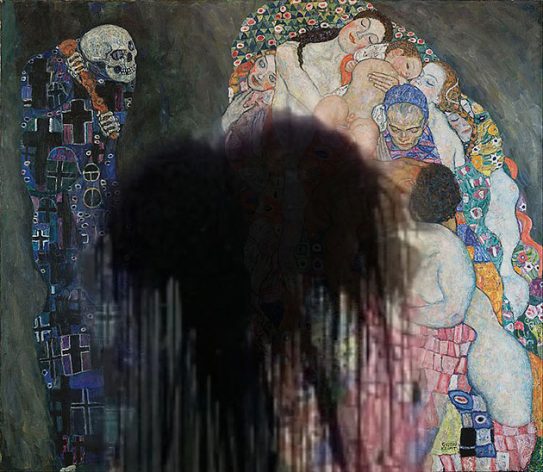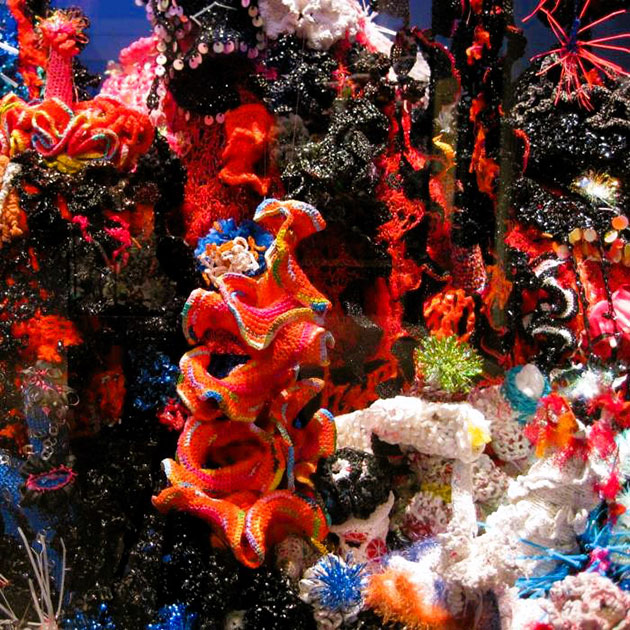Art and Climate Change

STOCKHOLM, Sweden, Dec 06 (IPS) - A dark cloud is hovering above human existence. It is a fairly illusory cloud haunting our minds and wellbeing, but also an actual, menacing, mostly invisible cloud that covers the Earth’s entire atmosphere. Saturated by greenhouse gases, this global threat increases with every year, threatening all life on Earth, causing increased flooding, extreme heat, draught, wild fires, rising sea levels, food and water scarcity, as well as diseases and mounting economic loss. This misery, caused by human greed, thoughtlessness, and self-aggrandizement, trigger human migration and armed conflicts.
If global temperatures keep rising and reach 2 degrees Celsius (3.6 degrees Fahrenheit) above pre-industrial levels, people will, worldwide and simultaneously, face the fatal and multiple impacts of climate change. A 2-degree rise in global temperatures is considered to be a critical threshold. In 2023, the average global temperature was on a third of all days at least 1.5 Celsius higher than pre-industrial levels, and the year is ending up as the hottest on record and – the year 2024 is expected to be even hotter.
Climate change poses a particular threat to children and youth and may potentially derail their normal development; affecting physiological systems, cognitive abilities and emotional skills in ways that may be irreversible. The emerging problems are manifold and the effects of these looming calamities make children and young people increasingly frustrated. Many youngsters feel threatened and betrayed by the behaviour of ruthless entrepreneurs and financiers, as well as poor and often corrupt governmental response to a disastrous climate change. Rampant climate anxiety motivates some young people to take action, not only through a recent surge in marches and the emergence of various environmental movements, but also in the form of violent and occasionally misdirected protests.
One of several means to draw attention to the threat of climate change are activists’ attacks on famous artworks. Since early 2022, artworks have been attacked all over Europe and the US. Mashed potatoes have been thrown on a Manet painting, chocolate cake smeared on statues, tomato soup on Van Gogh’s magnificent depiction of sunflowers, and oil-like substances thrown on several other paintings, like Klimt’s Death and Life. That painting is found in the Leopold Museum in Vienna, which presents some works form the dispersed Lederer art collection. The Lederer was a Jewish art collecting family, who among others financially supported the now renowned artists Klimt and Schiele. In 1938, the Gestapo expropriated all of Lederer’s possessions. Some of the confiscated Klimt paintings were by Nazi authorities stored in a castle, burned down by a German army unit just before the Soviet Red Army appeared. Seventeen Klimt paintings and frescoes perished in the fire, one of the few salvaged artworks was Klimt’s Death and Life, now smeared with a black substance
The spokesperson for one of several climate activist groups, Just Stop Oil, that attacks works of art has declared: “If things need to escalate then we’re going to take inspiration from past successful movements and we’re going to do everything we can.” What he meant by “successful movements” was among other incidents when a lady in 1914 slashed a Velasquez painting with a meat cleaver, protesting the arrest of the defender of women’s rights, Emeline Pankhurst. The enraged woman explained: “I have tried to destroy the picture of the most beautiful woman in mythological history as a protest against the Government for destroying Mrs. Pankhurst, who is the most beautiful character in modern history.”
Angry members of Just Stop Oil shouted, as they were hindered from attacking paintings at the National Gallery in London: “What is worth more, art or life?” A member of the group stated after throwing soup on a van Gogh painting: “The cost-of-living crisis is part of the cost of oil crisis. Fuel is unaffordable to millions of cold, hungry families. They can’t even afford to heat a tin of soup.” A somewhat awkward statement by someone who demonstrated disrespect of food by throwing it on a masterpiece of world art. Another declared: “We’re not killing anyone, climate change will.”
Supporters of “climate action groups” have defended them by saying that so far, no piece of art has been “permanently destroyed”. However, it is at best a half truth. In May last year, a self-declared “environment activist” tried at the Louvre to smash the glass protecting Mona Lisa. When he was hindered from concluding his deed, he succeeded in smearing cake on the painting. Last month, two women did with hammers smash the glass protecting the same Velasquez painting that was slashed in 1914, screaming that they were intending to rip it to pieces once more.
Another member of Just Stop Oil defended the various actions of the group and warned that they could worsen: “The function of art is for people to be able to understand the world that they live in and reflect on the human condition, but big art isn’t fulfilling that function. That’s the reason for us to be in museums: to tell people that we are in the middle of an emergency, and it is the time now for you to face that emergency.”
She was right by stating one of art’s essential functions. Artistic works have existed for almost as long as humankind and is an expression of humans’ creative and imaginative abilities, involving technical proficiency, beauty, emotional power, and conceptual ideas. Art helps us to perceive the beauty of the world we live in, the happiness we find among other human beings, in nature and animals, in all creation. It inspires reflection, willingness to act, imagination and innovative thinking. How can defenders of the preservation of nature and human rights imagine that the destruction and profanation of art may amend climate change? I assume that the enclosed mind of such activists, like ISIS fanatics, believe that their specific message and destructive actions take precedence over everything else, not the least other people’s feelings and intention to defend the very same values those fanatics, in their twisted minds, declare they are supporting.
I understand the frustration, but not the means. Like spoke-persons for Just Stop Oil, leaders of ISIS could declare that their destruction of World Heritage was to grab the world's attention by assuring extensive media coverage and international condemnation from those they considered to be their opponents and antagonists.
Instead of destroying art, “climate activists” would probably benefit from supporting and using it as a means to overcome humans’ tendency to value personal experience over scientific facts, assuming that everything will be alright by not acting in time. Art can be a persuasive means to popularize and make understandable data-based representations, making them vivid and accessible. Art can engage viewers and hopefully stimulate them to make an effort to hinder the worlds’ sloping down towards Armageddon.
Artistic endeavours to depict, present and make us aware of the dangers of climate change is increasingly becoming more common and engaging. This “Climate Change Art” assumes a wide array of forms and expressions. Often with an engaging, awareness raising component of personal commitment.

The Institute for Figuring (IFF), which in 2003 was founded in Los Angeles by Margaret Wertheim and her twin sister Christin, is a non-profit organization generating projects at the intersection of art, science and mathematics. One IFF project is the so-called Crochet Reef, which all around the world engages professional artists, scientists and groups of amateurs. The Crotchet Reef has become one of the largest participatory art and science endeavours in the world. By creating giant installations mimicking living coral reefs and crocheted out of yarn and re-used plastic, harvested from debris in the Pacific Ocean, the project engages associations which members are learning and applying mathematics, science, handicraft, environmentalism, and community art practice, while promoting awareness of the effects of global warming. Project creations have all around the world been successfully displayed in galleries and museums.
More modest activities, but nevertheless quite extensive, are various happenings, like those of Eve Mosher, who draw a blue “high-water” line around Manhattan and Brooklyn, indicating areas that would be underwater if climate change predictions are realized. She has since drawn high-water lines around Bristol, Philadelphia and coastal cities in Florida. In 2018, Xavier Cortada placed signs in front yards throughout Miami, indicating each property's height above sea level to illustrate how sea level rise would flood the owner’s land.
A sophisticated, renowned and multifaceted artist is the Danish-Icelandic Olafur Eliasson, who creates large-scaled installations employing elemental materials such as light, water, and air temperature to enhance the viewer's experience and create an awareness of humans’ intimate connection with nature, how its changes are influencing us, both in a positive and negative manner. Eliasson has founded a “laboratory for spatial research” that engages a large team of architects, engineers, craftsmen, and assistants, working together to conceive and construct large-scale sculptures, installations and other artwork, highlighting what happens to and on our living planet.
Awareness of the dangers faced by or planet, its ecosystem and organic lifeforms, including humans, is on the rise. At all levels of human existence an ever-increasing creative power is making itself evident; in art, literature, religion and science. To vanquish the threats to our planet we have to leave destruction behind us and become more creative, more willing to cooperate with one another, more tolerant, more respectful. Destroying art, our common human cultural heritage, is an entirely wrong way towards a brighter future and just like the emissions of greenhouse gases it must immediately come to an end.
IPS UN Bureau
Follow @IPSNewsUNBureau
Follow IPS News UN Bureau on Instagram
© Inter Press Service (2023) — All Rights Reserved. Original source: Inter Press Service
 Global Issues
Global Issues